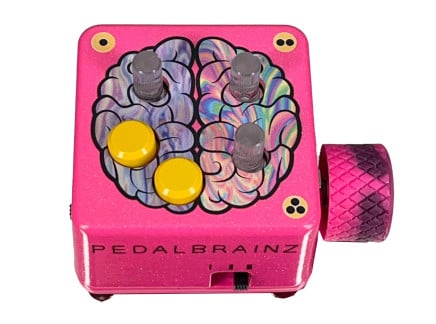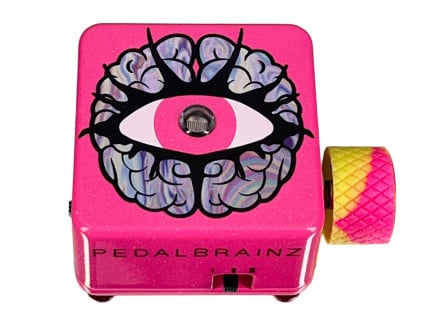Damian Kastbauer (aka LostChocolateLab) is a Seattle based technical sound designer, who has for a number of years worked as the Wwise product manager, spending over a decade working in the game audio industry. Damian put together a two-part book on his insights in the area, which be found on his website. He’s also hosted a podcast and worked on numerous games.
Now he brings to life Pedal Brainz! Pedal Brainz are devices that can be used for creative application in music or sound design. Presently the line up includes: Left Brain (an expression pedal with fifty patterns of light based modulation as well as loop recording), 3rd Eye (a light-dependent resistor modulator), and No-Brainer (for manual gain control).
Damian was kind enough to sit down and elaborate on all his various sonic creations and endeavors.
An Interview with Pedal Brainz
Kallie Marie: Tell us how you decided to start and found Pedal Brainz.
Damian Kastbauer: I’m a guitar player that was introduced to the wild sounds of Shoegaze when I was growing up; fascinated by the textures and techniques of the instrument, pushed to the edge of perception. This led to an ever expanding array of effect pedals, towards an ambient practice rooted in improvisation. [I was] always reaching for ways to extend the possibility [of] space—unlocked through cascading waves of delay,reverb, distortion, and the explosion of DSP accessible on the pedalboard.
Eight years ago I started adding expression pedals to dynamically control the parameters of different effects, starting with a pair of foot controllers to change the clock speed on a couple of modified Ibanez DM1000 rack mount delays. Things escalated quickly—to the point where I had five different foot controllers to modify different properties of effects with expression capability—but still only two feet to control them! (And still more effects on the pedalboard with expression potential…)
From there it was a process of finding ways to open up the opportunity that expression offers, without having to rely on foot control.
KM: What was your first product/project or prototype?
DK: Pedal Brainz started with a few wires, a 1/4” TRS jack, and a simple potentiometer. This was me learning how passive resistance is used to modify the reference voltage coming from an effects expression jack: a knob to take the place of a foot-controlled potentiometer and the seeds of what would become the Pedal Brainz No-Brainer.
From there, it was the realization that the variable resistance of a potentiometer could be exchanged for a photoresistor. Modulating resistance with light instead of controlling it by hand (or foot) resulted in the Pedal Brainz 3rd Eye. Any method of changing the amount of light reaching the “Eye” of the photo-resistor would dynamically change the expression amount; like a flashlight in a dark room or the flicker of a screen, computer monitor, or television.
Once the foundation for light-based expression had been laid, it dawned on me that I could create patterns of light that could be used to automate expression property modulation. This sent me down the rabbit-hole of Arduino programming, leveraging the many flashing light tutorials and examples that eventually arrived at the Pedal Brainz Left Brain. The Left Brain is a platform for expression modulation built around the Adafruit QTPY, that includes 3 LED backlit controls for light pattern adjustment, 2 buttons to navigate between preset Banks and Modez, along with an internal LED flashing controllable patterns of light at an internal photo-resistor.
KM: What is your favorite device you’ve created so far, and why?
DK: The Pedal Brainz Left Brain is the culmination of what I’ve been reaching for, to extend the possibilities of effects with expression capability. The patterns of light range from simple square, triangle, and sawtooth waveforms with controls for speed, depth, and other aspects all the way to the other side of the modulation spectrum featuring several non-repeating, constantly evolving waveforms based on Strange Attractor mathematics while providing controls to constrain or unleash the range of randomness.
When used with an effect pedal, the Left Brain brings expression modulation, in a way that can bring surprise and delight to my improvisational practice. A couple of my favorite applications are to set up an evolving randomization, to control the rate of a tremolo, slowly ramping between speeds while I play off the changes [in an improvisational way], or recording a custom pattern of light, using the “Light Loopz” recorder and applying it to the feedback of a delay causing runaway chaos when the light is at its brightest. In this way, my pedalboard, effects, and system of playback is always bringing something dynamic and unexpected, that pushes my practice beyond what’s available by default.
One of the delightful side effects of creating these devices, first and foremost for my own practice, but also selling them to other Sonic adventurers, is hearing the creative ways that people bring Brainz to their music. I’m a huge fan of the musician releasing music as Grain Blanc, who has been leveraging the Left Brain to bring wild warbles and subtle undulations to their field recordings and synthesis; not to mention the demo artists who’ve created some incredible audio visual illustrations to help people understand what’s possible with expression across the different Pedal Brainz models.
KM: How long does it take you to build them, and is there anyone helping you?
DK: Pedal Brainz is a small operation, run out of the garage, where I’m building small batches of different Brainz for direct sale and in collaboration with MAS Distro, who help put Brainz in the hands of retailers all over the world (including Perfect Circuit!).
Batches come together with the help of Scott and his team at Obscura Manufacturing, who are in charge of the tiny enclosure milling, sparkle powder coating, and UV printing. Additionally, Knob Head PDX has been there from the start and created a custom knurled and swirled knob that is the cherry-on-top of every Brain.
I’ve experimented with scaling the operation by bringing in folks to help with soldering and assembly, but the whole process has a lot of touch-points from me along the way. Everything from parts sourcing, inventory, and documentation to PCB design, programming, and artwork has been cultivated over the years, arriving at something that I feel encompasses a clear vision for unlocking expression in effects.
It’s hard to calculate the amount of time I’ve spent over the past 3 years to arrive at a place where I can bring a Brain to life. It starts with the PCB, including surfacemount components assembled at the factory, and then the surface mount parts are soldered on. From there, loading the custom (and open source) software onto the internal Arduino and finally assembling the physical device, enclosure, and testing completes the process. Building a single Brain clocks in at about an hour, which doesn’t account for time spent before getting to that point.
KM: Are you developing anything new right now?
DK: I just launched the Control Voltage series of Pedal Brainz across the three models, taking the initial passive resistance expression series further, with the ability to directly output CV for effects and synthesizers. This falls right in-line with the world of effects pedals opening up to provide semi-modular expression capability using CV, that can easily interface with modular synths. Folks like Dreadbox, Fairfield Circuitry, Glou Glou, Discomfort Designs, Vongon (and more) have been putting 1/8” jacks on their effects, and opening the door to easier control. Additionally, most effect pedals can use CV directly when bypassing the internal reference voltage using the TRS “floating ring” technique.
For me, control voltage was a natural next step that pushed me off into the deep end of trying to understand the delivery of consistent voltage that is scalable, compatible, and flexible enough to interoperate between effects and synths. So, the CV series of Brainz includes features like: Unipolar (0-5V) and Bipolar (+/-5V), the ability to scale and invert voltage, and takes Brainz to the next level by offering even more ways to deliver expression on the pedalboard.
It’s been super inspiring to hear what folks get up to with Brainz and, with the new CV series, patching directly into synthesizers has been mind blowing! I’ve been able to drop Brainz into a few folks’ modular rigs and the results have been incredibly creative and musical...I never imagined being able to “hear” the modulation of Pedal Brainz in that way. Meanwhile, I can’t wait to hear more from folks who adopt Pedal Brainz as part of their practice.
KM: What’s the hardest part of creating these?
DK: Education has been a surprising aspect of the Pedal Brainz story, in a few different ways. First, there are no standards for expression control across manufacturers, which is why the first series of passive resistance Brainz includes a switch to change between different maximum resistance values, making them compatible across the largest number of effects.
Second, the use of control voltage with effects is equally hard to understand. Unlike modular synths, where you can pretty much plug anything almost anywhere and feel secure that voltages will interoperate without the risk of damage. Whereas, the aforementioned lack of standardization means that effect pedals could expect a return voltage anywhere between 2.5V to 10V depending on the manufacturer. That’s why the voltage output on the CV series of Brainz can be scaled for compatibility using the Scale knob available on all models. (While most effects pedals also include protection agains incorrect, or over voltage, not all of them do. It’s always a good idea to check the expression specs in the manual, or by reaching out to the builder.)
And finally, the use of expression is sometimes beyond the expectations people bring to their practice. Encouraging the use of expression to extend the capabilities of effects beyond the defaults, or even implementing a traditional foot controller, is something that the small community of expression device builders continue to shine a light on. Folks like Leems Industries (GLEEMS, MEEMS, STREAMS), El Garatge (Echo Knob, Triple3X, WEX), Minta Labs (Lewis), Old Blood Noise Endeavors (Expression Ramper, X3, MTET), and others are out there advocating for the use of expression with effects pedals by creating unique devices that help illustrate the musical possibilities waiting to be unlocked on the pedalboard.
At the recent Portland Synth and Pedal Expo I gave a presentation called “Express Yourself : Using Expression and Control Voltage with Effects and Synthesizers”—going deep on the technical details, while also providing some examples of different kinds of expression. I also had the opportunity to talk with the folks at the Object Worship Podcast about Pedal Brainz, expression, and control voltage.
KM: What projects are you working on right now (not just Pedal Brainz) that you are excited about, and what can you share about them?
DK: Now that the Pedal Brainz CV series has been released, I’m excited to put the CV series of Brainz to use in more than just a testing capacity as part of my own ever-expanding system of playback. With branches of my pedalboard that go from mono, to stereo, to quad outputs, I’ve got a lot of opportunities to introduce subtle (or not so subtle!) modulation across the different paths that my guitar signal can take. For me, it’s the moment-to-moment decision making process, and reaction to what’s happening, that informs each improvisation, resulting in something different every time.
So far this year I’ve released a series of 3 improvised sessions (May You Have, What You Need, When You Arrive) that all feature a pile of Brainz. I’m looking forward to pushing further into the outer limits of expression and control voltage with Pedal Brainz!















